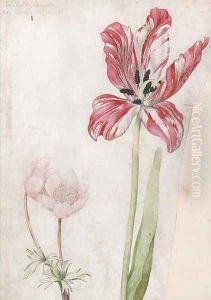Lady Edward Fitzgerald Paintings
Lady Edward Fitzgerald, born Stephanie Caroline Anne Syms, also known as Pamela, was not an artist in the traditional sense of painting or sculpture but played a significant role in the political and social circles of her time, which had a profound impact on the culture and art of her era. Born in 1773, her life was a fascinating journey that intertwined with the turbulent history of Ireland and France during the late 18th and early 19th centuries.
Pamela's origin has been a subject of speculation; some believed she was the daughter of Philippe Égalité, Duke of Orléans, while others claimed she was the daughter of Madame de Genlis, the governess of the Duke's children. Regardless of her mysterious parentage, Pamela was raised in France and became involved in the political drama of the French Revolution. Her life took a significant turn when she married Lord Edward Fitzgerald, a prominent Irish revolutionary who played a key role in the 1798 Irish Rebellion against British rule.
The marriage linked Pamela to the heart of Irish and French revolutionary politics. Despite her non-Irish background, she embraced the cause of Irish independence and became deeply involved in her husband's political activities. After Lord Edward's death in 1798, Pamela faced numerous challenges, including imprisonment and the struggle to secure her husband's inheritance for their children.
In the years following the rebellion, Pamela's life remained intertwined with the political developments of the time. She lived through the Napoleonic Wars and witnessed the profound changes sweeping across Europe. Despite the personal losses and the political turmoil, she remained an influential figure, known for her grace, intelligence, and the support she provided to the Irish cause. Pamela died in 1831, leaving behind a legacy tied not only to her husband's revolutionary efforts but also to her resilience and the cultural connections she fostered between France and Ireland during a pivotal period in history. Her life story is reflective of the complexities and the intertwined nature of European political and social histories during the late 18th and early 19th centuries.
